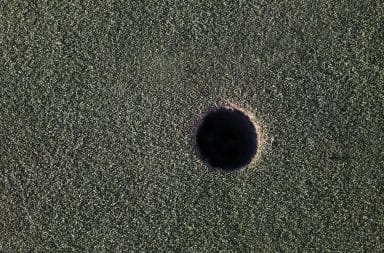The Outie
If you look at your abdomen, you’ll notice it; it sticks out like a sore navel, because it is. Very sore and very serious. Roughly 10 percent of people have an outie, making it as prevalent as other diseases like Alzheimer’s or left-handedness. It's easy to mistake your outie for a pimple or an extroverted innie, mostly out of denial.
Having an outie is the result of a doctor removing the umbilical cord as if it were a power cord he was hastily yanking out of an outlet by its cable. You probably have a sense of inferiority to people with innies, but a sense of superiority to kangaroos and other marsupials that lack belly buttons of any kind. If you or a loved one has an outie, see a doctor immediately. Doctors are great at small talk, and good conversation will keep your mind off that disgusting navel.
The Innie
Not to be confused with a dimple or a bullet wound, the “innie” forms when the extraction of the umbilical cord yields an outie, but the outie overhears the doctor using profanities and thus recoils back into the body, confused and afraid. Innies can be round-shaped, oval, hexagonal, cube-shaped, or even Roman Catholic. Innies are the most common type of belly button, so if you have an innie, you’re not alone nor are you special.
In early February, those with innies all look down at their concave navel to see if it has become an outie as yet. If not, there will be six more weeks of winter. While some people don't use their navel, most people use their innies to store their meds for the day. If you want to use that innie to store nuts for the winter, you’re out of luck; innie are known to only hold three to four almonds at a time.
The Deep Innie
The way to a man’s heart is through his stomach, and the way to his stomach is his deep innie. The deep innie is characteristic of people who can afford the procedure or who have a powerful enough drill. Deep innies are great for holding things like cheese fondue or your city’s freshwater supply. To help visualize a deep innie, hot glue a Styrofoam cup to your abdomen. To the untrained eye, you’ll have a deep innie. While the deep innie may make you look six strings short of being an acoustic guitar, benefits of the deep innie include having a great conversation starter, looking amazing in a crop top, and immortality. The deeper the innie, the longer the immortality.
The Quantum Navel
Discovered by Erwin Schrödinger while giving his cat a tummy rub, the quantum navel is the superimposition of an innie and an outie. There is also a non-negligible probability that the navel is neither an outie nor an innie but rather a cosmic black hole, the deepest innie. To help you understand the quantum navel, imagine throwing a dart at a map of the world. That dart can land either in the Northern or Southern Hemisphere, but it can also hit Kentucky. That dart is your navel. If you have a quantum navel, don’t look at it because then it is confirmed to be one state, and really this natural phenomenon is the only thing you have going on right now.
No Belly Button At All
Because minimalism is key, and because that genie took your “flat stomach” a bit too literally. Some people are concerned that having no belly button means they’ll be shunned by society, and they couldn’t be more correct. They will be found and exiled to Greenland where we keep the others. A belly button is a sign of birth, and it’s hard to hold a conversation with someone if you can’t talk about the pain your mother experienced during your birth. You can try talking about the weather, but good luck with that, because people without belly buttons cannot see rain. They just see a very overcast day. If you meet someone sans navel in person, feel around the midriff region to make sure it’s not just Photoshop. If the person was fine with you feeling the midriff region, you just gained a friend, and Greenland just gained a citizen.
One With an Umbilical Cord Sticking Out
Not all heroes wear capes, and not all doctors have experience. Even with a great doctor, the umbilical cord can be hard to separate from the child either because it’s clingy or because it’s doing a spot-on impression of a steel beam. Dubbed “the external tapeworm,” the still-attached umbilical cord is typically sentient, meaning you can treat it like the younger brother you never had. Just make sure it’s potty-trained.
Whether you find your umbilical cord a lot to handle emotionally or you just can’t finance its tuition to Dartmouth, feel free to consult your doctor about having it removed. You’ll come to find the umbilical cord has asked that same doctor about having you removed, so this doctor has a tough decision ahead of her.


